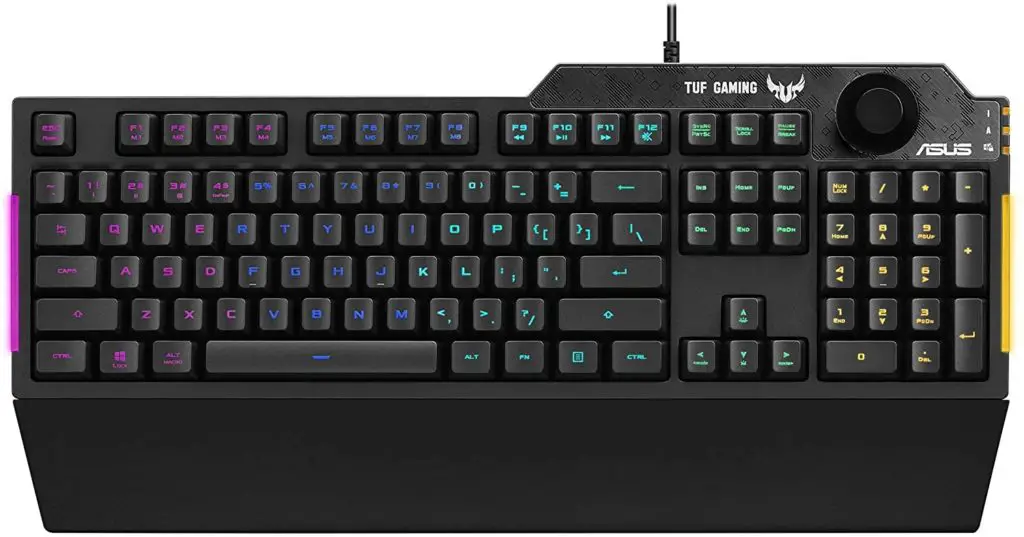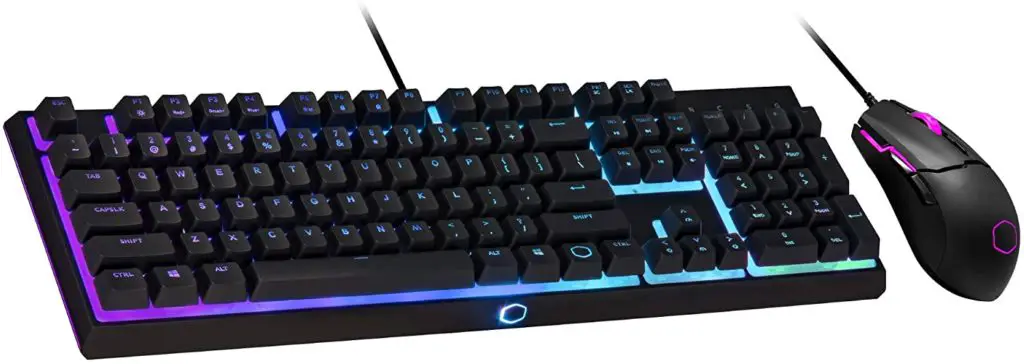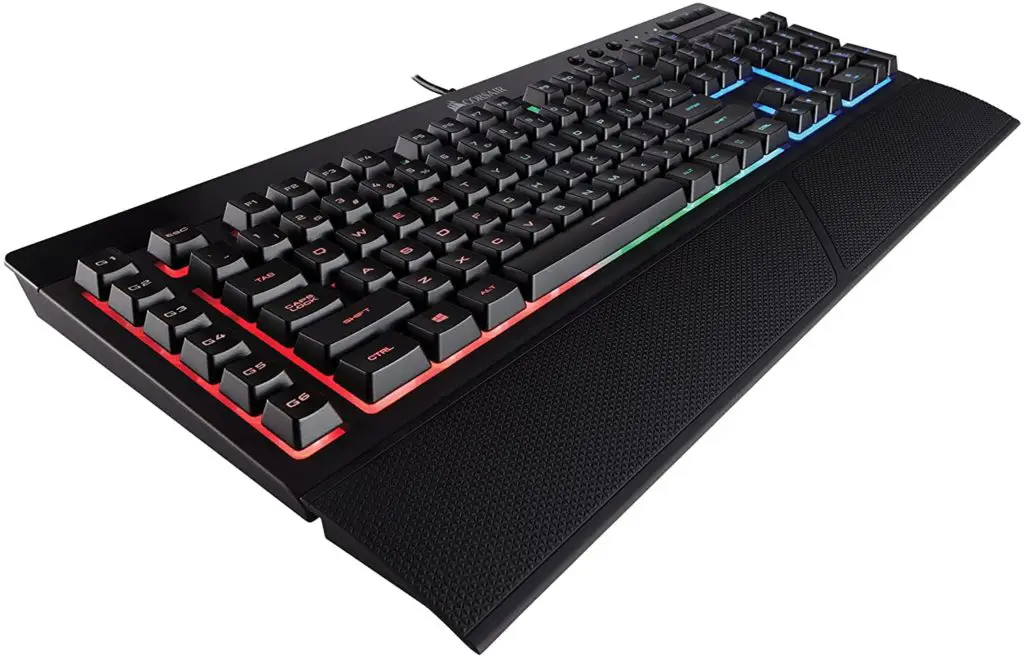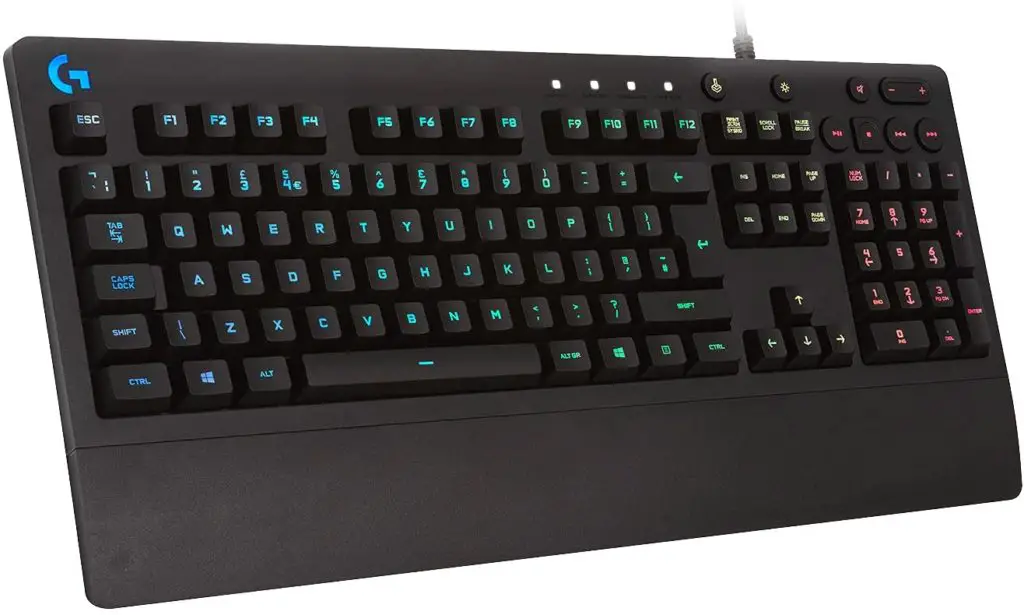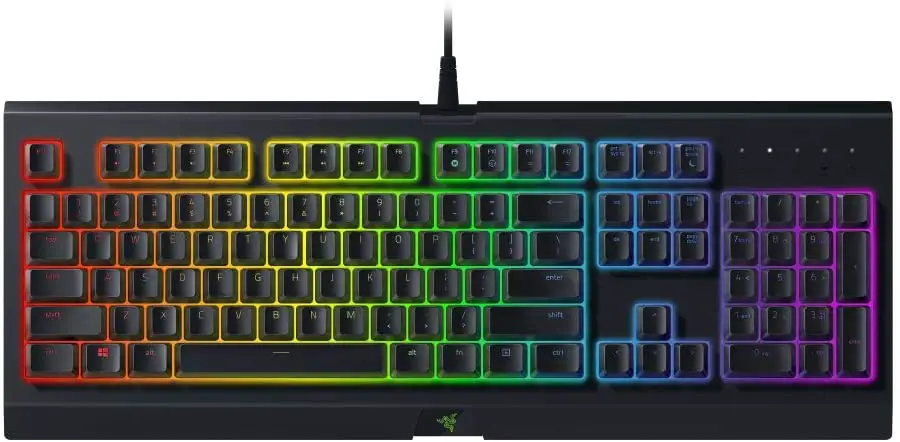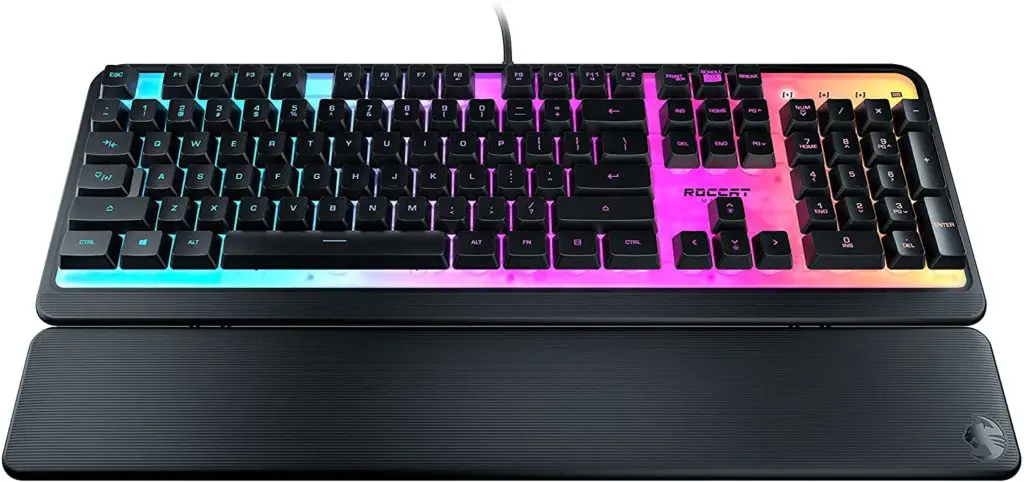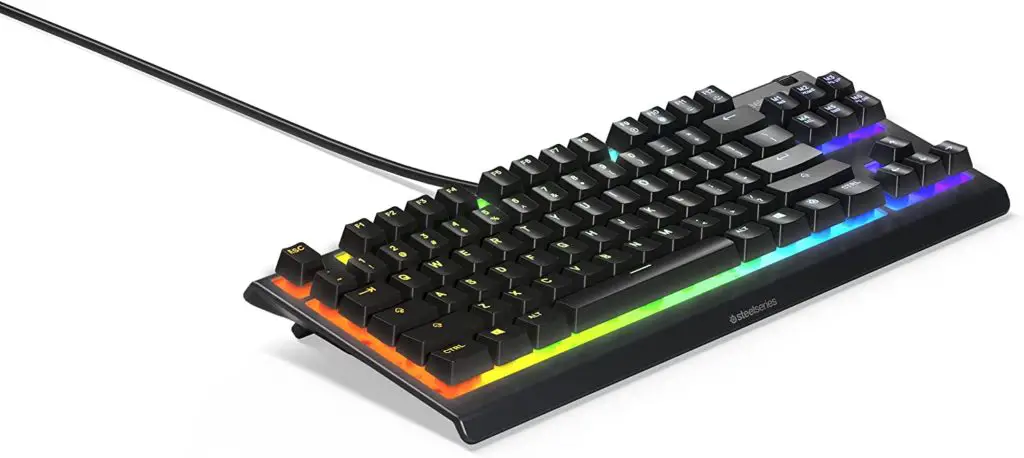Most of the keyboards in this Labs test can be bought for under $50, which inherently means the features you get aren’t quite at the same level as on more premium mechanical boards. None includes a USB pass-through, for instance, while per-key backlighting is a rarity, with lighting instead split into zones on most of these models. Premium touches, such as the aluminium top plates that Corsair favours for its expensive keyboards, are also out the window.
What you do still get with nearly all these keyboards, though, is some form of multimedia control, so you can adjust volume, and play and pause your media at the touch of a button. RGB lighting abounds too, while easy key remapping and macro recording is provided by software for most of these keyboards.
The rubber dome switches used in these keyboards don’t have the longevity or variety of feedback available with mechanical switch keyboards. However, most of them are still rated to last for many millions of key presses, and offer an improvement in build quality over the very cheapest rubber membrane keyboards.
We tested each keyboard both in games and with multiple typing speed tests to ensure the keys provide an accurate, rapid response. We also assessed the feel of the keys to gauge the smoothness, definition and consistency of the response, while testing for noise with a decibel meter held at head height facing the keyboard. Any extra features were also tested and the general build quality, design and overall feature set was assessed.
List of Top Rated Soft Touch Keyboards
- ASUS TUF GAMING K1
- COOLER MASTER MS110
- CORSAIR K55 RGB PROXY
- LOGITECH G213
- RAZER CYNOSA CHROMA
- ROCCAT MAGMA
- STEELSERIES APEX 3 TKL
1- ASUS TUF GAMING K1
While most of the keyboards on test this month include some sort of multimedia controls, either via secondary functions of the standard keys or via dedicated buttons, the Asus TUF Gaming K1 is the only model to offer a proper big chunky volume wheel, and it makes for a surprisingly meaningful upgrade over those fiddler alternatives. It’s large enough to easily make small adjustments, helped by the detents that let you know each time you’ve moved the dial up or down a notch.
Unfortunately, adjusting volume is this dial’s only purpose – you can’t tap it to mute or play/pause media, or control any other aspect of your system. Given there are no other dedicated media controls, this feels like an oversight. That said, most of the time, it’s easy enough to play/pause media with a tap of the spacebar, assuming the relevant window is highlighted, and fine volume adjustment is the most crucial element that needs a dedicated control. Plus, there are labelled secondary functions of the F9-F12 keys that provide back, play/pause, forward and mute controls. It’s just not as quick to use them as having dedicated controls.
Also available via secondary functions of the F1-F8 keys are macro recall and recording, using the keyboard’s on-the-fly macro recording. Otherwise, that’s it for extra keys and other functions. You do, though, get an included clip-on wrist rest that has a reasonable depth and slopes down to a pleasant shallow point. However, it isn’t quite as deep as the rests on the Corsair and Roccat keyboards, so it doesn’t offer quite as good support.
On the bottom of the keyboard, you’ll find rubber-tipped, single-level flip-down feet for raising the back of the keyboard, while the fixed USB cable sprouts from the back of the board, around a third of the way in from the right edge. When it comes to styling, Asus has kept true to its long-standing TUF brand theme, with a chunky, militaristic vibe running throughout the keyboard. It has also added RGB strips to the sides, which provide a little extra eye candy.
The lighting is split into five zones, with a handful of wave and breathing type effects available, as well as the option for a static colour of your choosing. In terms of practicality, the lighting isn’t the best we’ve seen. It isn’t distributed all that evenly under each key, so there are dark patches that make the key legends unclear – it’s not a problem when viewed top-down, but it’s tricky to make out quite a few legends from a normal sitting angle.
We also struggled to get Asus’ Armoury Crate software working. It would simply get stuck on a spinning circle loading screen whenever we selected the keyboard from the program’s device menu.
More successful are the key switches, which offer a well-balanced action with a defined but not overly stiff bump. The keys also responded rapidly and the keycaps felt solid and secure, making for an easy and reasonably quiet (55.4dB) touch-typing experience (66 words per minute, at 98 percent accuracy).
Conclusion
The Asus TUF Gaming KTs volume wheel is a great example of the benefits of proper chunky physical control surfaces. However, it’s otherwise not the most feature-rich keyboard. The uneven backlighting when viewed from an angle also harms the readability of the key legends. Otherwise, it’s a solid enough keyboard, with a good typing action.
2- COOLER MASTER MS110
The Cooler Master MS110 is a distinctly different offering to the other keyboards on test this month, for several reasons. The first and most fundamental one is that it’s not just a keyboard, but a wireless keyboard and mouse combo.
There’s a similar MK110 keyboard and CM110 mouse available separately, but the former isn’t readily sold, while the latter is slightly different to the mouse included in this set.
The second big difference is that this keyboard uses a so-called ‘mem-chanical’ key switch that emulates a mechanical switch’s form but uses a rubber dome mechanism. The primary benefit of this, other than the impressive 50 million keystroke rating, is that you can actually pull off the keycaps and replace them with Cherry MX-style keycaps.
The downside to this approach is that the MS110 keyboard retains one of the main problems of mechanical switches, which is a clackity noise. This doesn’t come from the keys bottoming out – as the rubber dome cushions the landing – but from the keys returning to their top position. The result is a keyboard that’s considerably louder than the others on test, clocking in at 63.5dB.
The action of the keys feels very different to most of the others on the test too. Rather Than the pronounced initial stiffness followed by a collapse, which is the signature action of rubber dome switches, here it’s much more linear. There is still a slight bump, but it’s much less pronounced. The result is easily the most comfortable keyboard on test, with a far more gentle press required to register a key response. This didn’t translate into faster or more accurate typing, but it was easier going on the fingers than some other keyboards.
Both the keyboard and mouse look great. Their simple black forms are punctuated by clean, simple and effective backlighting elements, such as the translucent sections below the keys, the thin strips of light around the edges of the keyboard and on the sides of the mouse, the glowing scroll wheel on the mouse and the elegant hexagonal Cooler Master logos.
Build quality is decent too. The keyboard is still very much all-plastic, but it’s a little sturdier than some models, and while the mouse lacks a little of the premium feel of high-end mice, it still feels perfectly sturdy. Weighing in at 89g and measuring 117 x 63 x 38mm, the relatively compact and short mouse is quite dense by today’s standards, but it’s not overly heavy.
Its sensor model isn’t stated, but it ramps up to 3,200dpi with a button in the centre for quick adjustment. Unfortunately, it didn’t keep up with our gaming demands, failing to maintain tracking in fast movements, resulting in skips in on-screen movement. Irritatingly, Cooler Master’s MasterPlus+ software didn’t recognise either device in testing either.
The keyboard offers no extra features as such, but a dozen or so of the keys are labelled with secondary functions, such as backlight brightness and colour adjustment, Windows key lock, and multimedia playback and volume control. On the underside, you’ll find rubberised, single-level flip-down feet, while the USB cable emerges from the middle of the back of the keyboard. No wrist rest is included.
Conclusion
The MS110 keyboard is a fantastic low-cost, rubber dome option, assuming you don’t mind it’s slightly loud keys. Its stylish, well made and the upgradable keycaps are a real boon. The MS110 mouse looks the part too, but its sensor is a letdown for gaming.
3- CORSAIR K55 RGB PROXY
orsair’sK55RGBProXTisthe most feature-rich of all the keyboards on test this month, and it comes with a correspondingly higher price. However, the price of $75 still puts this keyboard well below the price of most mechanical keyboards, and it really does come packed to the gills with features. First off, this is an extended-range keyboard, with six extra dedicated gaming keys running down the left side.
All the board’s keys are fully programmable, but having dedicated ones means you don’t have to worry about using awkward key combinations or losing any other functions. Just beware that there’s a potentially frustrating learning curve involved with avoiding hitting the G keys when you’re aiming for the column of Esc-to-Ctrl keys.
On the opposite end of the keyboard are all the multimedia buttons, of which there are plenty. You get dedicated buttons for stop, back, play/pause, forward, mute, volume down,volume up, macro record, backlight brightness and Windows key lock functions, putting pretty much every standard feature we can imagine to hand.
Next up on the hit list is the fact that this keyboard has individual backlighting for each key, which few of the other gaming keyboards on test offers. This allows for smoother colour effects than zone-based lighting, and of course, means you can program the board to display whatever pattern you like. Corsair’s software is also a cut above most offerings on test in terms of ease of use and features.
The final main physical feature is the inclusion of a wrist rest, which is a sizable unit measuring 65mm deep and gently sloping down to provide a surprisingly comfortable rest. A higher, cushioned wrist rest – or simply keeping your hands raised – is always preferable, but this is definitely one of the more comfortable included rests we’ve used.
Around the back andon the underside, there’s far less going on with this keyboard. There’s none of the cable-routing channels of the SteelSeries, northe USB pass-throughs you’ll get on premium boards. The unbraided cable is fixed and just straight out the middle of the back of the keyboard, and there are basic, single-leveLflip-down feet on the underside.
When it comes to build quality, all the keyboards on test are plastic fantastic, but the shinyuppersection of the Corsair doesn’t really do it any favours. That said, overall, it still feels decent enough, with a surprising lack of flex even when the rear is raised, despite the extra width of this keyboard. Corsair has also slapped an IP42 rating on this board, giving it the same splash resistance as the SteelSeries and one level higher of solid object protection – it’s rated to keep out objects over mm in diameter, up from objects over 2.5mm on the SteelSeries.
Meanwhile, Corsair’s rubber dome switches have a pronounced and guite stiff bump, making typing more of an effort than on some keyboards in this Labs, and markedly more than with mechanical boards. This didn’t affect our typing speed or accuracy particularly, but it’s more fatiguing in use. The keys are very quiet, though, with a noise measurement of just53.2dB.
Conclusion
The K55 RGB Pro XT is a very versatile keyboard, with masses of extra buttons for getting the most out of your games and multimedia. The per-key lighting is also a major boon at this price range. The key switches are quite stiff, though, making typing guite an effort.
4- LOGITECH G213
While most of the other keyboards on text hover around the $50 mark, the Logitech G213 stands apart with its exceptionally low price of just $35, yet it gives up very little in terms of features. As well as its five-zone RGB backlighting, you get nine dedicated extra buttons and a built-in wrist rest, which is more than several other more expensive keyboards on test.
Take a closer look at this board and the first feature that strikes you is the integrated wrist rest. Presumably it reduces machining costs to just build the whole keyboard longer, rather than providing the clips and holes for attaching a wrist rest. Regardless, if you already have a preferred separate wrist rest, or prefer not to use one at all, this keyboard is immediately off the list. Thankfully, as hard plastic wrist rests go, it’s a little longer and more supportive than some models, although it can’t compete with the much more generous rests on the Corsair and Roccat Models.
The other striking feature about this board is its styling. Logitech’s gaming peripherals have a particularly simple look that’s a cross between ‘utilitarian’ and ‘child-safe’, as demonstrated by the rather oversized multimedia buttons in the top right corner of this keyboard. It’s a clean look but it’s also a little drab.
One aspect of its appearance that makes a good impression, though, is the backlighting.Logitech has taken completely the opposite approach to most of the other manufacturers in this test and specifically tried to block any light from leaking out around the keys, instead confining the backlighting to just the legends of the keys. It makes for a really smart look that gives an impression of precise build quality, belying the $35 price tag. The lighting only has five zones, but effects such as the wave pattern flow far more smoothly than this spec would suggest.
In terms of extra features, the main additions are the extra buttons in the top right corner. Here, you get a Windows key lock button, a backlight brightness control, mute and volume up/down, plus four media playback buttons.
On the underside, you also get single-leveL, flip-down feet, which provide a surprisingly large raise to the back of the keyboard. Meanwhile, the fixed cable exits towards the right-hand side of the back.
So far so good for the G213, assuming the wrist rest and styling are to your taste; however, we encountered a number of build quality issues in actual use. The first is that despite the extra rigidity you’d expect from the integrated wrist rest, this keyboard flexes a touch more than some others on test – it was just about noticeable while typing.
Even more problematic is that several of the keys and buttons didn’t work properly on our brand-new review sample. The volume up button requires a hard Press to register and it makes a loud click, while the volume down button pleasantly responds to a soft touch.
The backlight brightness adjustment button simply didn’t work on our sample, while the ‘G’ key was temperamental, requiring a hard press to register. Unfortunately, we weren’t able to obtain a second sample for comparison before publication, but it looks as though there are some quality control and consistency issues.
Conclusion
With its integrated wrist rest and intriguing styling, the G213 is likely to divide opinions, but it certainly offers plenty of features for its price. Unfortunately, that low price is seemingly reflected in its quality control.
5- RAZER CYNOSA CHROMA
The Razer Cynosa Chroma is the slightly older variant of the two Cynosa rubber-dome keyboards you can currently buy, with the newer V2 model adding dedicated multimedia keys to the mix. The Cynosa Chroma has a comparatively basic feature set, but it includes per-key backlighting and it also benefits from Razer’s ever-reliable eye for attractive design.
The styling here is guite simple, with just a single piece of unadorned black plastic wrapping over the top, back and front of the keyboard, which is punctuated only by the sunken translucent sections for the keys and the little cutout for the shiny piece of plastic with the Razer logo at the front. This simple, clean approach, along with a sharp choice of key legend font and Razer’s neat-looking logo, makes for an effortlessly smart, if rather chunky-looking keyboard.
The backlighting looks very good too, thanks to the combination of translucent plates doing a good job of distributing yet containing the lighting, and of course, the per-key RGB programmability. This allows for pre-programmed lighting effects, such as wave, breathing and a rather funky fireemulating effect, and they look far smoother than the effects on some keyboards on test this month with only limited lighting zones.
However, we found the lighting could sometimes have a distracting flickering to it if you move your eyes rapidly. We’ve noticed this before on some RGB keyboards, and it’s a product of the way they rapidly flash the LEDs on and off in order to regulate their brightness, in the same way as some old monitors (which is why many monitors now make a big point of claiming to be flicker free). The other RGB keyboards on test didn’t suffer from this problem, and we found it quite annoying on the Razer.
To program the lighting, you’ll have to jump into Razer’s Synapse software, which is frankly a bit overblown for its job. You have to sign up to a Razer account in order to access it, and it’s all split up into confusing modules that require individual downloads. A more integrated, all-in-one approach – that doesn’t require a sign-in – would be far preferable.
When it comes to features, this keyboard has no physical extras beyond the normal keys, but it does include multimedia and macro recording functions as secondary functions of the F keys.On the underside there are two-level, plastic flip-down feet for raising the back, and the USB cable sprouts from the centre of the back of the keyboard. Meanwhile, build quality is surprisingly solid for the price, with the Cynosa Chroma being among the more rigid devices on test.
The key switches here are simply labelled as being of a rubber membrane type, with no lifetime rating. Nonetheless, they feel pretty good in action, with a slightly less aggressive push required to buckle the rubber dome than with some keyboards on test. There’s still a distinct feedback, but it doesn’t verge on being fatiguing. The feel is also reasonably consistent across the board.
Performance-wise, the board didn’t lead the pack in our typing speed tests, but it didn’t noticeably feel like it was holding us back. It’s a reasonably quiet keyboard in action too, registering just 52.5dB in our tests.
Conclusion
The Razer Cynosa Chroma is a slightly older keyboard, and in some ways, that shows, with the newer V2 version offering multimedia buttons for a similar price. However, it’s still a perfectly smart-looking, capable and quiet keyboard. It’s just the slightly irritating flicker of the backlighting that holds it back.
6- ROCCAT MAGMA
The big selling point of the Roccat Magma is its lighting setup. It makes use of a translucent top plate in order to provide lighting for not just the keys, but also for the entire top of the keyboard. On paper, it might sound a bit gimmicky, and the look of the keyboard doesn’t initially inspire confidence when you get it out of the box unplugged either. You’re greeted by a big slab of white plastic that we suspect doesn’t quite fit in with the aesthetic of most desk setups.
However, plugging this keyboard into your gaming PC and its party piece makes a more convincing case for itself, assuming that you love RGB lighting. The show put on here is quite striking and there’s a certain practicality to it too. It lights up your keyboard/desk area, providing a little bit of ambient, eyestrain-reducing light. Plus, you’ll certainly know when it’s time for a keyboard clean-up.
The lighting is divided into just five zones. For effects, you get some basic breathing, heartbeat and wave effects, along with an AIMO intelligent mode that reacts to your interactions, plus a static colour choice. Beyond just choosing a static colour scheme, we have to admit to not really being taken in by any of the effects on offer, other than multicolor waves, but that’s a matter for your own personal tastes.
horizontal line motif running along the front edge and onto the included plastic wrist rest. The rounded corners of the keyboard, along with the white-on-black look, also has a toy-like or child-friendly appearance to it in our eyes, though again whether you like the styling or not is really just a matter of Personal taste.
As for build quality, the keyboard has a disconcerting amount of flex in it in use – it’s among the most flexible keyboards on test. It’s not so bad that typing makes the whole unit wobble, as can happen with poor-quality gaming laptop keyboards, but it’s a touch more pliable than some of the other keyboards on test in this month’s Labs.
In terms of features, you get the aforementioned wrist rest, which offers a decent depth to it, so it actually supports your wrist rather than just filling space under your hand, as with some small wrist rests. It’s hard surface will irritate your wrists after a while, though, so you’ll need some sort of cushioning for it in the long term.
Otherwise, there are no real extra physical features. Instead, all this keyboard’s extra abilities are confined to the secondary functions of the primary keys. All the keys are fully programmable, but by default, the F keys have various labelled secondary functions, such as volume control, media control and a profile switching button.
The keyboard uses Roccat’s own membrane switches, for which the company hasn’t provided a lifetime rating. However they appear to use a very similar structure to the switches on the Corsair K55 RGB Pro XT. They feel different, though, with slightly less force required to push past the initial resistance, which we preferred. Typing performance was excellent, and the Roccat was the quietest unit on test.
Conclusion
If illumination is your inspiration, then the Roccat Magma certainly makes an impact. It’s a shame the light show isn’t a little more fine tunable but it certainly looks the part when glowing away. There’s not a lot else to this keyboard, but the key action is decent and it’s also quiet.
7- STEELSERIES APEX 3 TKL
If we had to pick our favourite keyboard on a test based on design alone, the SteeLSeries Apex 3 TKL would easily take the win. It certainly helps that the compact tenkeyless (TKL) form factor looks a little less bulky than the full-sized keyboards on test, but the full-sized version of this keyboard looks great too. Instead, it’s the subtler details that really elevate this keyboard.
For a start, the backlighting is neatly contained in translucent, sunken sections that provide an attractive way for the lighting to fill out below the keys without spilling everywhere. The lighting is also split up into eight equal-size columns – more than some keyboards – allowing for a particularly attractive flowing, colour-shift effect. You can change the speed and colours of this effect, choose a breathing transition or opting for a static colour.
The shape is smart too, with sides that angle inwards towards the desk, creating a slim look. It also balances clean lines with just the right amount of rounding to its edges to soften the whole design. The compact volume wheel integrated into the top-right edge and the play/pause button below it are also handy additions. Tap the wheel and it will mute audio as well, while the play/pause button will also skip forwards a track when double pressed and go back a track when triple pressed.
You don’t get too many other features on the top of the keyboard but there are marked secondary functions for the F10-F12 keys that provide macro recording and brightness adjustment plus the Del/PgUp cluster provides six macro shortcut keys.
Flip over the keyboard and you’ll find that, although the USB cable is fixed, its cable can be routed to exit the back of the keyboard in three different locations, either from the middle or a couple of inches from either side of the keyboard. There are also surprisingly sturdy, rubberised flip-down feet. There’s no included wrist rest though.
Further nod to the Apex 3’s design is the font on the keys, which is very large, easy to read and smart-looking, although the way the letter legends are pushed to the top left of each key is a little odd.
The keys use SteelSeries’ Whisper-Quiet switches, which are rated to 20 million key presses. They have a very stiff initial step to their action, so require a bit of freedom to press, which we found a touch fatiguing and slightly slowed our typing.
They’re very responsive, though, not requiring you to hammer down the keys to get a response, and the initial resistance may soften a little over time. To call the keys ‘whisper-quiet’ is certainly a stretch, but along with the Roccat Magma, they’re the quietest on test, registering just 51.6dB.
SteelSeries also claims the Apex 3 is the first-ever water-resistant TKL gaming keyboard, which may well be true, but the waterproofing level claimed here certainly has its limits. The level of protection for an IP32 rating requires resistance to vertically dripping water with the device either flat or angled up to 15 degrees from its normal position, so it’s more resistant to splashes than full-on spills.
Conclusion
The SteelSeries Apex 3 TKL is a great little rubber dome keyboard. It looks smart and has a well-balanced feature set with its smart multi-function multimedia buttons. Add in the waterproofing, quiet keys and decent price, and you have a winner, if you don’t mind the fairly heavy key press.
Also See:
